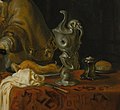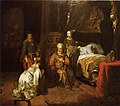
Gerbrand van den Eeckhout was a Dutch Golden Age painter and a favourite student of Rembrandt. He was also an etcher, an amateur poet, a collector and an adviser on art.

Abraham Bloemaert was a Dutch painter and printmaker who used etching and engraving. He initially worked in the style of the "Haarlem Mannerists", but by the beginning of the 17th-century altered his style in line with the new Baroque style that was then developing. He mostly painted history subjects and some landscapes. He was an important teacher, who trained most of the Utrecht Caravaggisti.
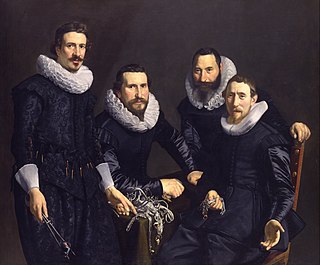
Thomas de Keyser was a Dutch portrait painter and a dealer in Belgium bluestone and stone mason. He was the most in-demand portrait painter in the Netherlands until the 1630s, when Rembrandt eclipsed him in popularity. Rembrandt was influenced by his work, and many of de Keyser's paintings were later falsely attributed to Rembrandt.
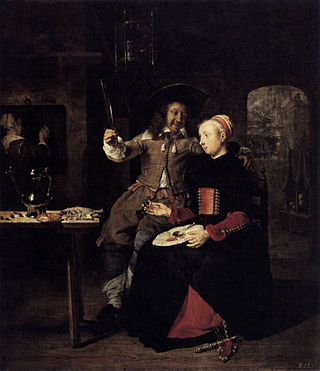
Gabriël Metsu (1629–1667) was a Dutch painter of history paintings, still lifes, portraits, and genre works. He was "a highly eclectic artist, who did not adhere to a consistent style, technique, or one type of subject for long periods". Only 14 of his 133 works are dated.

Hendrick Jansz ter Brugghen was a Dutch painter of genre scenes and religious subjects. He was one of the Dutch followers of Caravaggio – the so-called Utrecht Caravaggisti. Along with Gerrit van Hondhorst and Dirck van Baburen, Ter Brugghen was one of the most important Dutch painters to have been influenced by Caravaggio.

Jacob Symonsz. Pynas was a Dutch Golden Age painter and draughtsman. He is best known for having briefly taught the painter Rembrandt in 1625.

Jan Jacobszoon Hinlopen was a rich Dutch cloth merchant, an officer in the civic guard, a real estate developer in the Jordaan, alderman in the city council and a keen art collector. He would have been elected as a burgomaster, if he had not died at the age of forty, an age considered acceptable to be eligible. He was a prominent patron of the arts in his time, and there is some speculation on being an influential protector of Rembrandt and it is likely that he had good connections with Gabriel Metsu. Hinlopen, like his father-in-law, Joan Huydecoper I, is known in art history because of the poems by Jan Vos reciting the paintings in his house and members of the family. These paintings are spread all over the world, the poems nearly forgotten.
Gerrit van Uylenburgh, also known as Gerrit Uylenburgh, was a Dutch Golden Age painter and art-dealer. He was the eldest son of Hendrick van Uylenburgh and took over the family art-dealing business after Hendrick's death and burial in the Westerkerk church in 1661. This business, then in a house on Lauriergracht, formerly owned by Govaert Flinck, played a key role in the art world of the Dutch Golden Age.
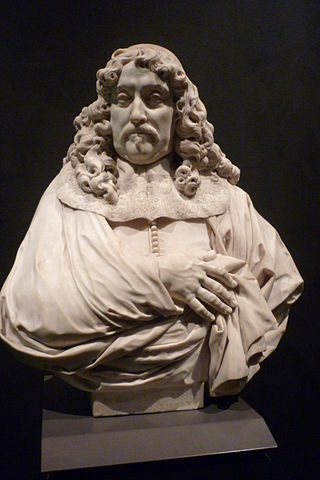
Andries de Graeff was a regent and burgomaster (mayor) of Amsterdam and leading Dutch statesman during the Golden Age.

The Continence of Scipio, or The Clemency of Scipio, is an episode in the life of the Roman general Scipio Africanus, recounted by the historian Livy. During Scipio's campaign in Spain during the Second Punic War, he refused to accept a ransom for a young female prisoner, returning her to her fiancé Allucius, who in return became a supporter of Rome. Scipio's magnanimous treatment of a prisoner was regarded as an exemplar of mercy during warfare in classical times. Interest in the story revived in the Renaissance and the episode became a popular topic for literary works, visual arts, and operas.
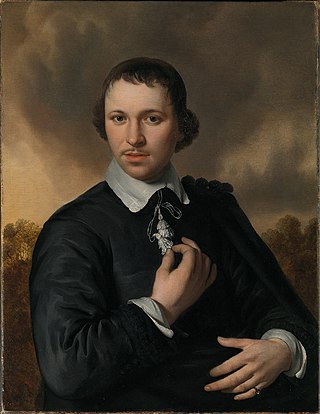
Jan van de Cappelle was a Dutch Golden Age painter of seascapes and winter landscapes, also notable as an industrialist and art collector. He is "now considered the outstanding marine painter of 17th century Holland".

Schelte a Bolswert or Schelte Adamsz. Bolswert was a Frisian engraver who worked most of his career in Antwerp where he was one of the lead engravers in Rubens' workshop. He is known for his reproductive works after Rubens and Anthony van Dyck.

Daniël Vosmaer, was a Dutch Golden Age painter.

The auricular style or lobate style is a style of ornamental decoration, mainly found in Northern Europe in the first half of the 17th century, bridging Northern Mannerism and the Baroque. The style was especially important and effective in silversmithing, but was also used in minor architectural ornamentation such as door and window reveals, picture frames, and a wide variety of the decorative arts. It uses softly flowing abstract shapes in relief, sometimes asymmetrical, whose resemblance to the side view of the human ear gives it its name, or at least its "undulating, slithery and boneless forms occasionally carry a suggestion of the inside of an ear or a conch shell". It is often associated with stylized marine animal forms, or ambiguous masks and shapes that might be such, which seem to emerge from the rippling, fluid background, as if the silver remained in its molten state.

Adam van Vianen was a leading silversmith of the early Dutch Golden Age, who trained as an engraver and was also a medallist. Unlike his brother Paul van Vianen, he spent little time away from his native Utrecht. Together they developed the auricular style which bridges the gap between Northern Mannerist and Baroque ornament.
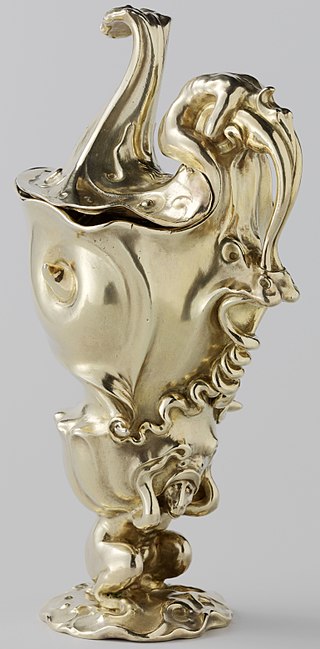
TheMemorial Guild Cupby Adam van Vianen is a 1614 silver-gilt covered ewer in the Rijksmuseum, commissioned by the Amsterdam goldsmiths' guild to commemorate the death of Adam's brother Paulus van Vianen. It is an iconic symbol of the auricular style developed by the two brothers.

The Continence of Scipio is a c. 1653 painting by Dutch artist Gerbrand van den Eeckhout. It shows the continence of Scipio and is now in the collection of the Rijksmuseum in Amsterdam.

The Adoration of the Magi, is a circa 1645 oil on panel painting of the Nativity by the Dutch artist Salomon Koninck in the collection of the Mauritshuis in The Hague.
Isaac Blessing Jacob may refer to:
The Continence of Scipio is the name of the following paintings:



